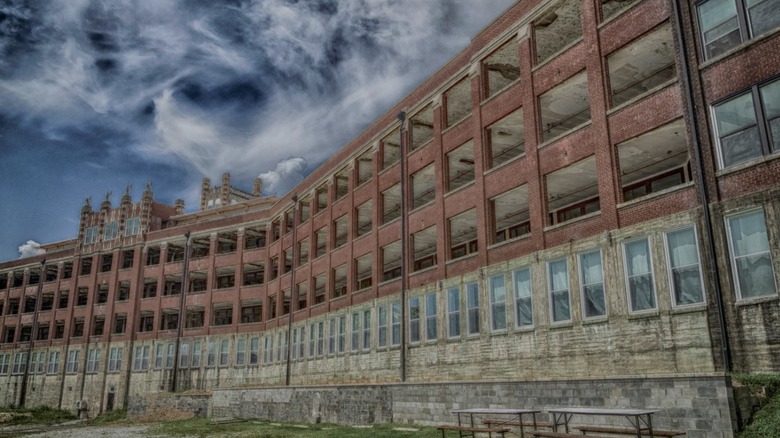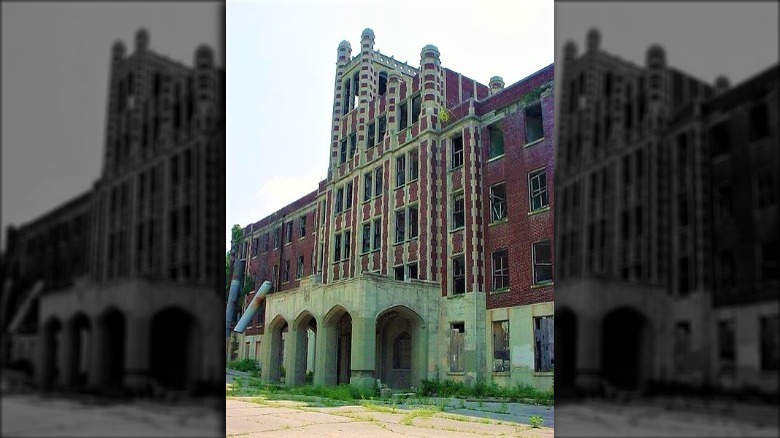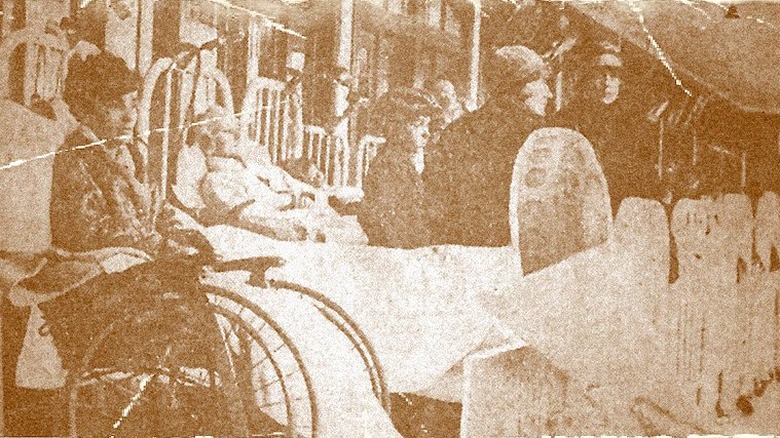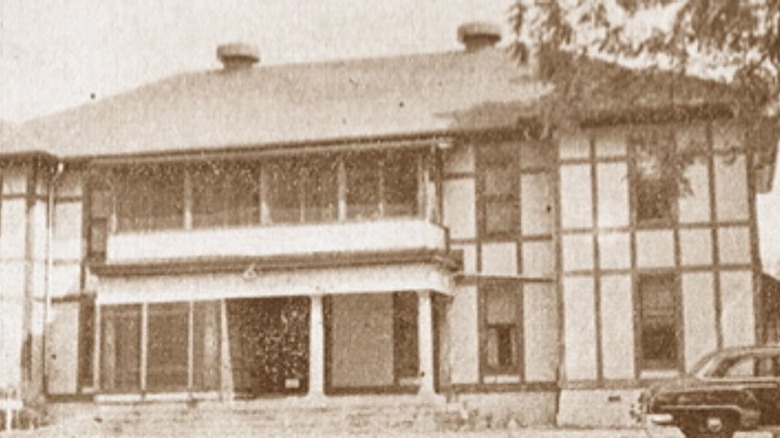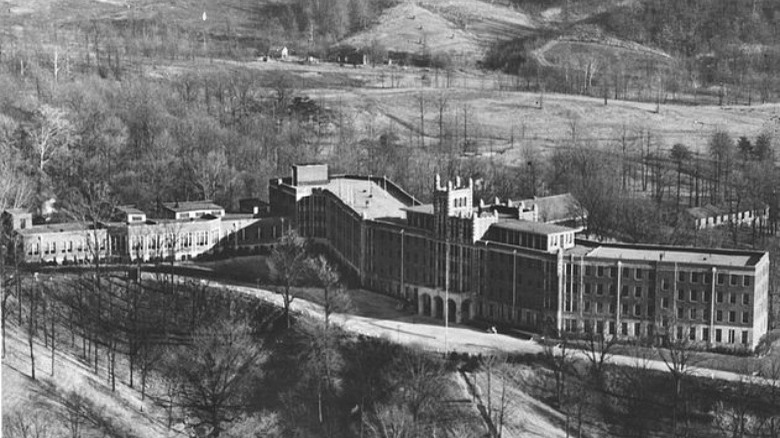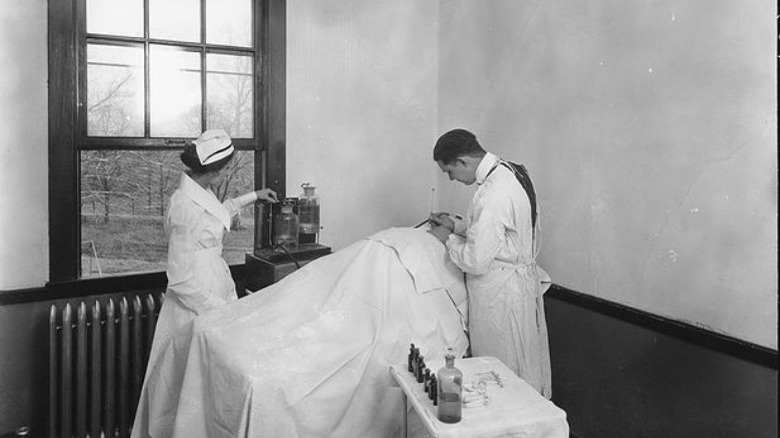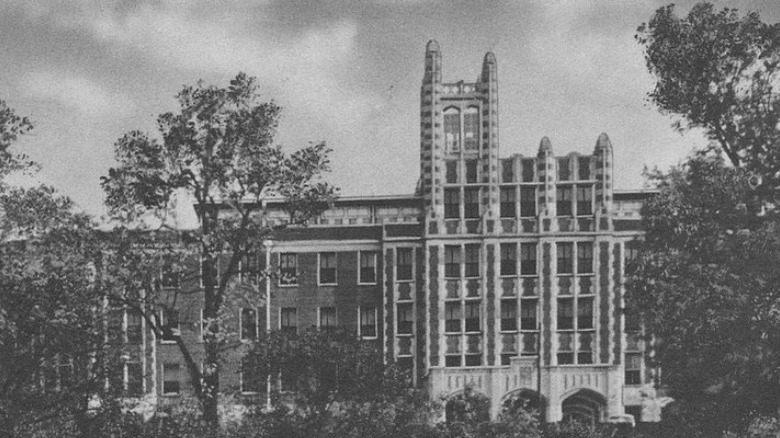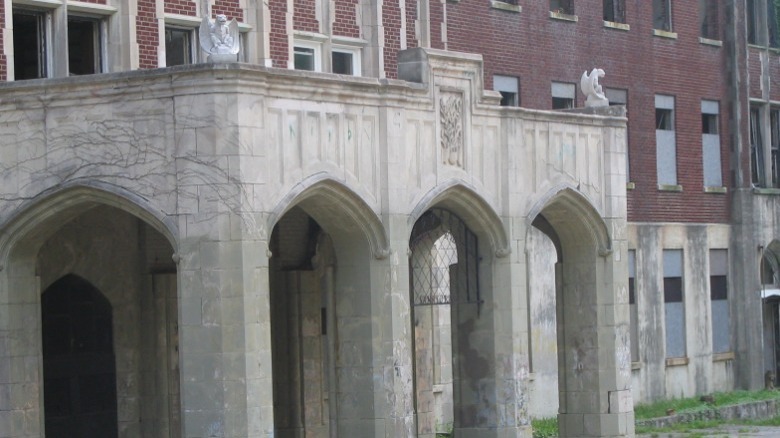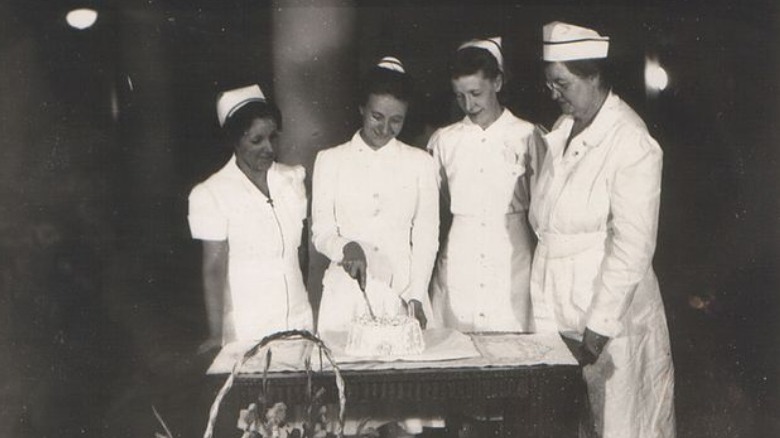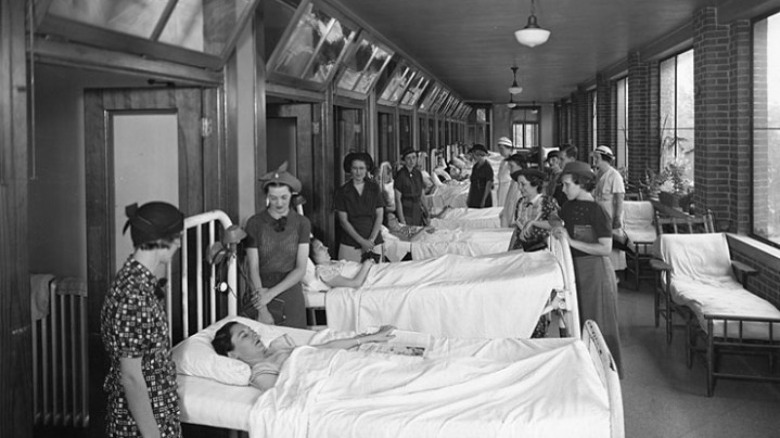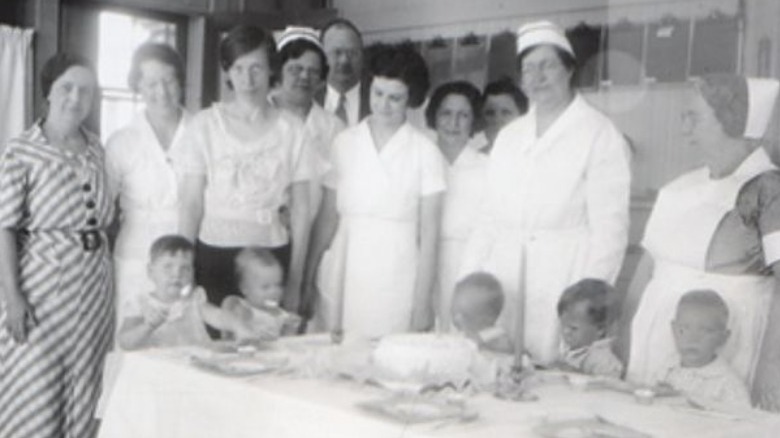The Disturbing True Story Of The Waverly Hills Sanatorium
In Louisville, Kentucky, stands a lofty, bat-winged gothic building that has a reputation that fits its somewhat spooky appearance. That reputation is as one of the most haunted places in America, being featured on such ghost hunting shows as "Ghost Hunters," "Ghost Adventures," "Paranormal Lockdown," and "Buzzfeed Unsolved." Its name is Waverly Hills Sanatorium, and in spite of its modern ghostly reputation, it was established as the best hope of peace for people struggling with tuberculosis in the first half of the 20th century. (Despite its name, Waverly Hills was not a mental hospital; a sanatorium is any institution that provides treatment and convalescence for chronic illnesses.)
Even in the face of the noble intentions of its administrators, Waverly Hills became the site of thousands of deaths in the face of a raging epidemic of a then-incurable disease. Here are just some of the horrible things that have led to Waverly Hills' reputation as a hotbed of unquiet spirits.
The earliest days of Waverly Hills Sanatorium
Waverly Hills wasn't originally a hospital; it was a home with its own little schoolhouse. As Kentucky Historic Institutions explains, the land was originally the family home of Major Thomas H. Hays, who bought the land outside Louisville, Kentucky, on which the sanatorium now stands in 1883. There were no schools in the area, so Hays decided to build a one-room schoolhouse for his own children. The teacher he hired was named Lizzie Lee Harris, who was a big fan of the long series of novels by Sir Walter Scott known as "the Waverley novels" and asked Hays if she could name the school the Waverley School. Hays agreed, and in fact he liked the name enough to call the entire property Waverley Hill.
By the early 20th century, tuberculosis was sweeping the United States, and Louisville was particularly hard hit because of its growing industrial economy and location within the Ohio Valley, both of which contributed to a lack of fresh air flow through the city. The Board of Tuberculosis Hospital was formed in 1906 to find an appropriate location for, well, a tuberculosis hospital, and Waverley Hill was thought to be an ideal spot due to its distance from the city, its quiet location, and its high altitude, contributing to air quality. The Board liked the name Waverley Hill and kept it, though at some unknown point, the second "e" was dropped.
Fighting death with good vibes
In the early 20th century, when tuberculosis was raging, there was no known cure, and although the disease had been around since antiquity, the source of the so-called "White Plague" wasn't fully understood. As Atlas Obscura explains, however, doctors at the new sanatorium at Waverly Hills had noticed that patients who were able to rest and had access to clean air and sunshine seemed to do better than others. As a result, much of the treatment at Waverly Hills was based on what the medical field refers to as "good vibes" (which stands in fairly sharp contrast to the building's current reputation as a hotspot for the unquiet dead, but c'est la vie).
The location of the hospital itself was meant to contribute to the atmosphere of peace and rest, with Waverly being placed on a tall hill surrounded by charming little woods with lots of access to sun and fresh air. The original facilities at Waverly included two large open-air pavilions where the patients were placed to receive their prescribed fresh air and sunshine. Abandoned Online adds that other original treatments at Waverly included diets rich in vitamins A and C and protein and lots of bed rest. Obviously these treatments weren't going to cure the disease, but the goal was to reduce suffering and, most importantly, help stop the spread of the infection.
Epidemic and expansion
As the official Waverly Hills site explains, the original sanatorium was a two-story frame building with a half-timber design, with an administration building and the open-air pavilions for the patients to be exposed to air and sun. This original building was meant to hold 40-50 patients at one time, roughly half male and half female. However, tuberculosis reached epidemic proportions by 1910, and Louisville was particularly hard hit due to its low-lying position on the waters of the Ohio River, and–according to Abandoned Online–Waverly was soon overwhelmed with over 140 patients in a facility designed for 40 people. As a result, construction soon began on a much larger, more permanent facility.
In 1924, construction began on a new building that would be four stories of brick and concrete sprawling across 180,000 square feet, including separate rooms for patients rather than communal ones, sunrooms, labs, and recreation rooms. This new hospital was designed to hold up to 400 patients. It turns out they would need the space. By the late 1930s, tuberculosis was the leading cause of death in Kentucky, and in fact, Kentucky led the nation in tuberculosis deaths, due to a lack of state funding, long-term treatment options, and more permanent facilities like Waverly. Some 2,000 people a year were dying of tuberculosis in Kentucky alone.
The world of Waverly Hills Sanatorium
While it might be nice to think about living in a community like Waverly Hills where the philosophy of treatment is "sunshine and good vibes," it's important to remember that tuberculosis was an incurable, highly contagious disease that was spreading at epidemic proportions. If you went to Waverly, you were never coming back. As the Waverly Hills site explains, the sanatorium subsequently became a self-contained community for not only their patients, but also the families of those committed to its care. (Although for some reason, a "visitors' day" was allowed, in which visitors could come, hang out with people with an infectious disease, and then go back to their lives.)
The community at Waverly Hills became essentially its own city, complete with its own ZIP code and post office. Much of life's necessities were carried out within this community, including raising their own fruits and vegetables; raising, slaughtering, and butchering their own meat; and maintaining their own water treatment facility. Other amenities included laundry facilities and an auto maintenance garage. These facilities had to support not only the patients of Waverly, but also the doctors, nurses, and other staff who worked at the sanatorium, who had to separate from the rest of society due to the disease's infectious nature. Likewise, the uninfected children of patients had their own floor in the sanatorium where they had to live apart from the outside world.
Waverly Hills Sanatorium wasn't all sunshine and fresh air
While it's nice to imagine Waverly's philosophy of making things as pleasant as possible for their patients suffering from tuberculosis worked, the fact is, there's a limit to how pleasant you can make life for someone who's constantly coughing up bloody mucus. So while it's true that the most common treatments were exposure to sunlight, bed rest, healthy foods, and fresh air, the Waverly Hills Sanatorium Memorial records that several other methods were applied to patients, including surgical methods that were cutting edge for the time, but that might sound barbaric now. These included perhaps most famously artificial pneumothorax, which involved blowing air into either the lung itself or the cavity between lungs in order to artificially collapse the diseased portion of the lung, allowing it to rest and (theoretically) allowing the lesions caused by the tuberculosis to heal. Patients who were unlikely to survive this procedure tried to maximize rest to their lungs by lying on the side most affected by lesions, restricting the movement of the diseased lung naturally with posture and gravity.
For some time, a commonplace surgery for the treatment of tuberculosis was thoracoplasty, which involves the removal of multiple ribs with the intention of collapsing the lung. While doctors preferred to only remove two or three ribs at a time, most patients required as many as eight removed for this technique to be effective, meaning they had to endure multiple painful surgeries.
The body chute
It's impossible to say how many people died at Waverly Hills during its time as a tuberculosis hospital, but the fact is that, during its years of operation, tuberculosis was the leading cause of death in Kentucky and had no known cure, so patients at Waverly were dying at a pretty steady clip. While the legendary claims that some 60,000 people died at Waverly are grossly exaggerated, LiveScience cites historians who say the actual number is more like 8,000 total, with a recorded 152 deaths in 1945, which was the height of the epidemic. Either way, there was no shortage of dead bodies that had to be moved out of the sanatorium, and patients seeing corpses being wheeled out on the regular would be pretty counterproductive to Waverly's "no bummers" approach to medical treatment.
As a result, for the purposes of maintaining as high a morale among the patient populace as possible, doctors and staff would move bodies in secret. As Atlas Obscura explains, the hospital housed a secret tunnel through which the administrators would wheel the bodies of those who had succumbed to the disease. This enclosed tunnel led from the hospital to train tracks at the bottom of the hill, where the bodies could be lowered to trains that would carry them away. Perhaps needless to say, this grim passage earned itself an equally grim nickname: "the body chute."
Closing Waverly Hills Sanatorium
Although Waverly Hills did their best to make life as comfortable as possible for their patients and their families, nothing was going to truly make things better until a cure for the disease was found. As luck would have it, 1943 saw the introduction of a new antibiotic called streptomycin that was an effective combatant against the infectious disease. However, as Kentucky Historic Institutions explains, this treatment wasn't made available to the patients at Waverly until 1949. Once it was, though, new patients could now be treated at a regular hospital as outpatients. Slowly but steadily, the population at Waverly Hills was decreasing, but, like, in a good way. Abandoned Online records that the number of patients dropped from 373 in 1950 to 293 in 1960. In 1962, Waverly Hills closed as a tuberculosis hospital and all of its patients were transferred to a regular hospital.
The buildings subsequently sat empty for nearly a year before the facility was reopened in 1963 as Woodhaven Geriatric Center, a live-in nursing facility for elderly patients with dementia, mobility issues, or severe mental disabilities. Woodhaven operated in this capacity until 1982 when it was closed by the state. A grand jury found multiple instances of patient abuse and signs of neglect of the facility itself. Woodhaven was closed and all of its patients were transferred to another care facility.
The logical next step
According to Kentucky Historical Institutions, after Woodhaven Geriatric Center was closed for criminal abuse, the majority of the land and buildings were sold off to a developer, who intended to use the main building as a minimum-security state prison. However, a massive wave of protests from locals quashed this plan, and the backup plan of turning the building into apartments also collapsed due to a lack of funds. In 1996, Waverly Hills was purchased by a non-profit ecumenical group to build the most logical possible thing for the location: the world's tallest statue of Jesus. The goal was to make a 150-foot-tall statue on the roof of the sanatorium modeled after the famous statue of Christ the Redeemer in Rio de Janeiro. However, the cost of the statue was estimated to be $4 million while the interior renovations turning the hospital into an arts and worship center would have been between $8 million and $10 million. Donations to the project totaled a mere $3,000, so giant tuberculosis Jesus was canceled.
The building and its surroundings were sold in 2001 to its current (as of this writing) owners, Charles and Tina Mattingly, who established the Waverly Hills Historical Society to raise money for the restoration of the building's interior. To this end, Waverly Hills now primarily serves as a haunted attraction, with ghost tours and annual haunted house events.
The ghosts of Waverly Hills Sanatorium
Let's be honest: it's no surprise that Waverly Hills Sanatorium is considered one of the most haunted places not only in Kentucky, but in the whole United States. Despite its being founded on the principles of feeling good all the time no matter what your lungs are doing, it's still a big spooky building where thousands of people died before being wheeled through a body chute when their Marilyn Manson surgery went bad. As LiveScience explains, various ghost hunters and spook chasers have reported encountering all sorts of creepy phenomena within the halls of the long-abandoned hospital. You've got your old standards, like unexplained footsteps and the slamming of doors, weird noises, and so on. Obviously as Waverly was a hospital, the sound of screaming patients is thought to emanate from the long-empty rooms. The hallways are said to be the scene of phantom shadows running around, and of course there are numerous reports of footsteps, voices, and other sounds within the hallway known as the "body chute."
American Hauntings reports sightings of more specific apparitions, including a ghostly hearse seen dropping off coffins at the back of the building, a woman with bleeding wrists begging for help, and a man in a white coat seen wandering around a trashed kitchen full of broken windows and destroyed furniture, accompanied by the scent of food.
The infamous fifth floor
As the legends go, the most haunted location in the entirety of the Waverly Hills facility is the fifth floor. According to American Hauntings, the legend is that the fifth floor was where the mentally disturbed patients were housed at Waverly. This floor, particularly Room 502, is the center of much of the ghost stories surrounding Waverly and was the area of prime interest for ghost-hunting teens breaking into the abandoned hospital for years. The stories say that it is on this floor that people have seen shapes moving in the windows, heard voices telling them to get out, and even–so they say–jumped to their own deaths.
The stories say that a nurse was found in Room 502 in 1928, having hanged herself from a light fixture. Apparently she was in despair over finding out that she was pregnant out of wedlock. Another nurse who worked Room 502 in 1932 is said to have thrown herself off the roof patio onto the ground below ... though some say she was pushed. (By a ghost? By the other nurse ghost? Who can say? We're just asking questions here.) Voices in the Attic reports that some pregnant visitors have felt extremely uncomfortable in Room 502, while others have felt supernaturally compelled to jump from the window, even to the point of having to be talked down.
The truth about the fifth floor
As is frequently the case, however, reality comes in to poop the party. American Hauntings explains that the legendary fifth floor of Waverly Hills was not at any point used to house or confine mentally ill patients. Its residents were just as free to move about the floor as patients on any other floor. In fact, the floor was designed for this exact purpose, with two wards centered around the nurses' station that were glassed in on all sides in order to maximize sunlight, according to Waverly's treatment philosophy. These glassed-in wards did, however, lead to rooftop patios such as the one the legends say the nurse jumped from, and from which visitors allege they've felt compelled to leap from.
To further kill the buzz, there are no records of any nurse suicides during Waverly Hills' years of operation, and what's more, Room 502 has no means by which a nurse could have hanged herself. The room has no rafters, the sprinkler pipes that exist in the room now weren't added until the 1970s, and the light fixture in the room is far too delicate to support the weight of a person. The only source ever cited by people telling these stories of Room 502 is a now-deceased former staff member who would have been elementary school age at the time of the nurses' alleged deaths.
Timmy and the Creeper
Outside of the fifth floor, there are a number of other commonly reported apparitions around the grounds of Waverly Hills Sanatorium. Voices in the Attic records the story of one famous enough to have a name: Timmy, the ghost of a young boy who wanders the halls. According to the stories, Timmy moves around the hospital, either playing with his own leather ball, or seeking something else to play with. Some guests have reported bringing balls of their own for Timmy, only to subsequently see those same balls floating down the halls, carried by an invisible hand.
Other common sightings include an older woman with chains around her wrists, often believed to have been a resident when the building was a geriatric center. Apparently this ghost howls for help only to run away screaming when anyone approaches her. Another notable apparition is known as "the Creeper," due to its creeping, crawling movements up and around the walls, ceilings, and floors. It's said that proximity to the Creeper brings with it an overwhelming feeling of dread. While there's no explanation for who or what the Creeper might be, some think he might have been a mistreated patient whose contorted appearance reflects the trauma they experienced in life. At any rate, that's a lot of darkness for a place founded on the principle of fighting disease with sunshine.
